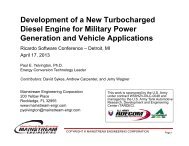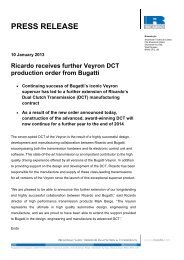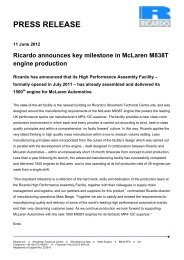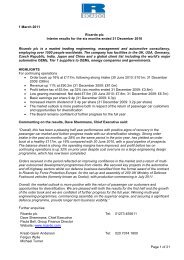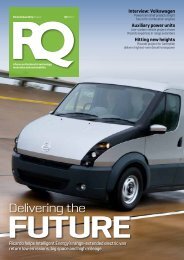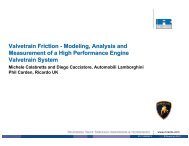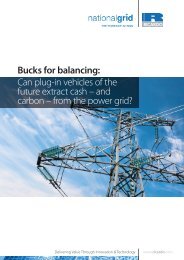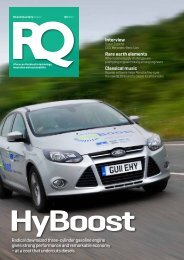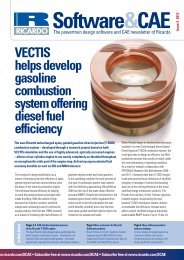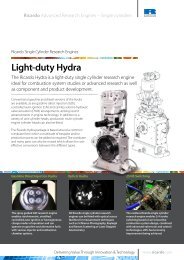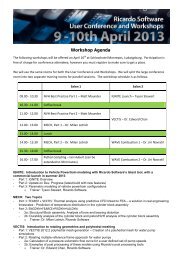CASE STUDY USING PISDYN OF THE EFFECT ON ... - Ricardo
CASE STUDY USING PISDYN OF THE EFFECT ON ... - Ricardo
CASE STUDY USING PISDYN OF THE EFFECT ON ... - Ricardo
You also want an ePaper? Increase the reach of your titles
YUMPU automatically turns print PDFs into web optimized ePapers that Google loves.
INTRODUCTI<strong>ON</strong><br />
A key asset of any simulation software is its ability to be easily used for parametric studies and<br />
optimisation. At ACL Piston Products in Australia, <strong>Ricardo</strong>’s <strong>PISDYN</strong> software is used to help<br />
design pistons. The key criteria used to evaluate piston skirt designs performed using <strong>PISDYN</strong><br />
are noise, wear, friction and fatigue strength. It is known that small variations in pin offset, skirt<br />
profile (the small variations in diameter of the skirt with height along the skirt) and skirt contour<br />
(the ovality in the skirt) can have a big influence on how well a piston performs on each of these<br />
criteria. <strong>PISDYN</strong> can be used to determine the most suitable combination of pin offset, skirt<br />
profile, skirt contour and in some cases land diameters for a particular piston application.<br />
Piston noise is caused by the slapping of the piston against the cylinder. This occurs as a result of<br />
the changing interplay of forces on the piston - due to cylinder pressure, inertia and the<br />
supporting force of the connecting rod - as it moves up and down the bore during a cycle. This<br />
noise is greatest when the piston is cold, as this leads to a larger clearance between the skirt and<br />
cylinder, allowing for greater kinetic energy, from lateral and rotational motion to be gathered by<br />
the piston before it impacts the cylinder. Piston noise tends to also be largest during engine start<br />
up when the oil film between the skirt and cylinder may be very thin.<br />
Piston noise problems are typically one (or both) of two types - "croaking" and "rattling".<br />
"Croaking" problems result from excessively strong impacts of the thrust side of the piston<br />
against the cylinder at a crank angle of around 10-40 degrees after TDC (top dead centre) at the<br />
start of the expansion stroke, while the engine is running at low speed and low load. "Rattling"<br />
noise problems result from excessively strong impacts of the top of the anti-thrust side of the<br />
skirt or the top land on the anti-thrust side against the cylinder around TDC at the end of the<br />
compression stroke, while the engine is running at about 2500-3500 RPM, with moderate load.<br />
2 of 13



